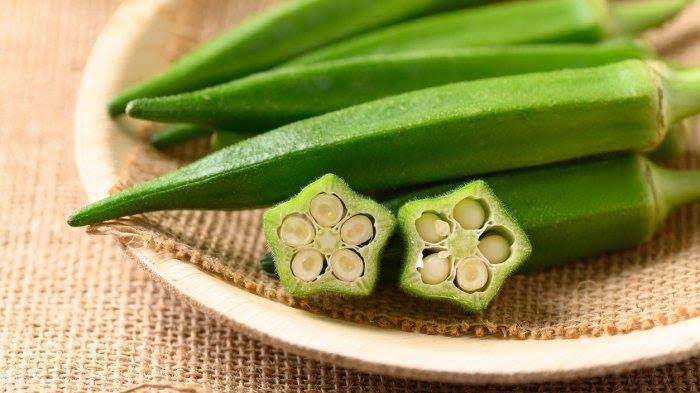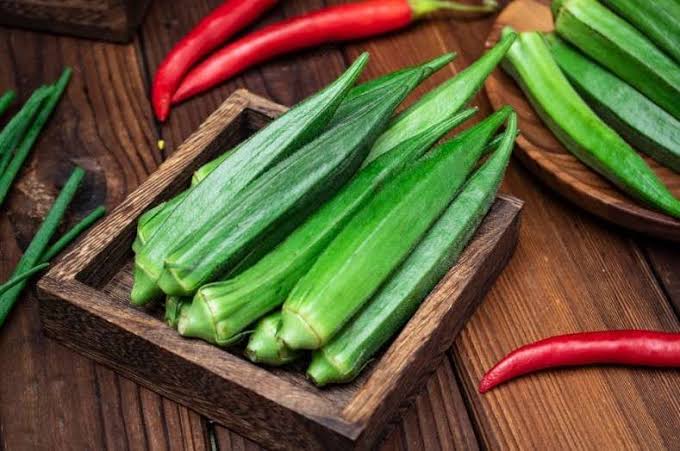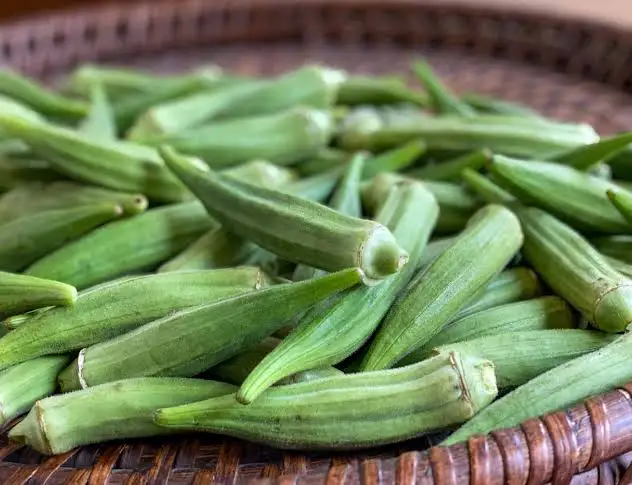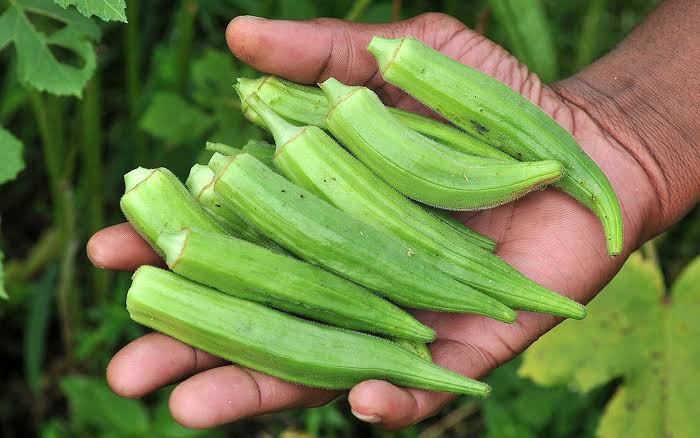Lady finger, also known as okra, is a versatile vegetable enjoyed in cuisines worldwide for its unique texture, mild taste, and health-promoting properties. Known scientifically as Abelmoschus esculentus, lady finger belongs to the mallow family, and it thrives in tropical and subtropical regions where it’s cultivated as a staple.
Its popularity extends from Africa to Asia, the Middle East, and the Americas. What truly sets lady finger apart is its nutritional value, as it’s packed with vitamins, minerals, and fiber that contribute to numerous health benefits. In addition, its culinary adaptability makes it a prized vegetable that easily finds its place in both traditional and modern recipes.
Lady finger contains several key vitamins, notably vitamins C, K, and A. Vitamin C acts as a potent antioxidant that supports immune function, promoting a stronger defense against infections and inflammation. Vitamin K plays a crucial role in blood clotting, which is essential for wound healing, while also contributing to bone health.
Meanwhile, vitamin A supports vision and skin health, while also acting as an immune booster. Lady finger also provides a good source of folate, which is particularly important for pregnant women as it aids in fetal development.
Additionally, its mineral content includes calcium, magnesium, potassium, and iron, all essential for bodily functions like bone density, muscle function, and blood health. A key feature of lady finger’s nutritional profile is its high fiber content, with both soluble and insoluble types.
This fiber is invaluable in supporting digestive health, as it promotes regular bowel movements and may help alleviate digestive issues like constipation. The vegetable’s fiber content also helps stabilize blood sugar levels, a benefit particularly relevant for those managing diabetes.
By slowing the absorption of sugar, lady finger can help prevent spikes and dips in blood glucose, making it a beneficial addition to a diabetic-friendly diet. Additionally, its fiber contributes to satiety, helping people feel fuller for longer, which can assist in weight management.
As a low-calorie food that is rich in nutrients, lady finger provides an excellent option for those seeking a nutrient-dense yet weight-conscious diet. Beyond its nutritional benefits, lady finger is prized for its unique mucilaginous, or slightly slimy, texture, which plays a distinctive role in culinary applications.
This mucilage thickens soups and stews, a feature that is highly valued in cuisines across Africa and the Southern United States, where dishes like gumbo incorporate okra for both flavor and texture.
When prepared properly, lady finger’s mucilage can also act as a natural thickener in other dishes, eliminating the need for additional thickeners. For those who are less fond of its mucilage, specific cooking methods such as roasting, grilling, or frying can reduce its sliminess, allowing lady finger to fit more seamlessly into a variety of recipes.
Lady finger’s versatility extends beyond its ability to thicken dishes. It can be prepared in countless ways—boiled, steamed, sautéed, roasted, or even eaten raw when young and tender. Each preparation method brings out different aspects of its flavor and texture, catering to diverse culinary preferences.
For instance, frying lady finger gives it a crispy texture, enhancing its flavor profile and making it a popular snack or side dish. On the other hand, when used raw, lady finger adds a refreshing crunch to salads, pairing well with fresh tomatoes, cucumbers, and herbs.
Beyond traditional recipes, lady finger has gained popularity in modern culinary innovations. Given its impressive nutrient profile and low-calorie content, it has become a preferred vegetable for health-conscious consumers and culinary enthusiasts alike.
Smoothies, stir-fries, and even baked goods have incorporated lady finger in creative ways, allowing people to enjoy its benefits in unique forms. Its mild taste ensures it complements various flavors, from spicy and tangy to mild and creamy, making it a versatile addition to countless dishes.
Lady finger’s nutritional profile and culinary appeal have made it a popular vegetable, but its uses extend beyond the kitchen. In traditional medicine, lady finger has long been valued for its potential medicinal properties. The seeds, for example, are rich in antioxidants, which may provide anti-inflammatory benefits.
Studies have suggested that the antioxidants found in lady finger could contribute to reduced risk of chronic diseases, including heart disease. Its high vitamin C content further enhances its antioxidant properties, helping to protect cells from damage caused by free radicals.
Additionally, lady finger’s fiber content has been linked to improved cholesterol levels, which may support heart health by reducing the risk of hypertension and atherosclerosis. Lady finger also finds its place in traditional herbal remedies for digestive issues.
Its high mucilage content, while often debated for its texture, may help soothe the digestive tract and provide relief for conditions like gastritis or irritable bowel syndrome. This mucilage can act as a gentle coating for the stomach lining, reducing discomfort and inflammation.
Moreover, lady finger’s low glycemic index makes it a valuable addition to diets focused on managing blood sugar levels, particularly for individuals with insulin sensitivity or diabetes. The vegetable’s fiber slows down sugar absorption, which can help prevent sudden spikes in blood glucose, offering a natural method to support blood sugar control.
The plant’s versatility, nutritional benefits, and medicinal uses make lady finger a valuable crop for both small-scale farmers and commercial agriculture. Its ability to thrive in warm climates and resist certain pests has made it an ideal crop in regions where food security and sustainable agriculture are key concerns.
Furthermore, lady finger’s adaptability allows it to be grown alongside other crops in intercropping systems, promoting biodiversity and enhancing soil health. Its relatively low demand for fertilizers and pesticides also contributes to its sustainability, making it an eco-friendly choice in agriculture.
Lady finger has gained increasing recognition as a sustainable, nutrient-rich crop with both traditional and modern appeal. Whether consumed as part of a traditional stew, blended into smoothies, or used in alternative medicine, lady finger offers a wealth of benefits that make it deserving of its place in the global diet.
Its nutrient-dense profile supports essential functions in the body, from digestion and immunity to heart health and blood sugar regulation. Meanwhile, its unique culinary properties allow it to adapt to a wide range of dishes and cuisines, making it accessible and enjoyable to people worldwide.
Read Also: The Origin and Significance of Ogbono Seed
Health Benefits of Lady Finger

1. Supports Digestive Health: Lady finger is packed with dietary fiber, which plays a crucial role in maintaining a healthy digestive system. Fiber promotes regular bowel movements and helps prevent constipation.
The vegetable’s high mucilage content also provides a soothing effect on the stomach lining, potentially offering relief for digestive issues like gastritis. Including it in the diet can enhance gut health, improve nutrient absorption, and support overall digestion.
2. Helps Manage Blood Sugar Levels: This vegetable has a low glycemic index, meaning it releases glucose slowly into the bloodstream, which can prevent sudden spikes in blood sugar levels.
This is especially beneficial for people with diabetes or those managing insulin sensitivity. The soluble fiber in lady finger slows down sugar absorption, which can contribute to more stable blood sugar control over time. Some research even suggests that regular consumption could help in preventing the onset of type 2 diabetes.
3. Boosts Immune System: Rich in vitamin C and antioxidants, this vegetable helps strengthen the immune system. Vitamin C supports white blood cell function, helping the body fight off infections and maintain resilience against diseases.
Antioxidants also play a role in neutralizing free radicals, protecting cells from damage, and reducing inflammation, which may help prevent chronic diseases. Consuming it as part of a balanced diet can help reinforce the immune system and keep illnesses at bay.
4. Enhances Skin Health: The antioxidants, vitamins, and minerals in lady finger contribute significantly to skin health. Vitamin C, in particular, is essential for collagen production, which keeps skin firm, smooth, and youthful.
The antioxidants found in this vegetable may also help reduce oxidative stress on skin cells, minimizing signs of aging such as wrinkles and fine lines. By incorporating this nutrient-rich vegetable, people can support healthy, radiant skin naturally.
5. Promotes Heart Health: Lady finger is beneficial for heart health due to its fiber content, which helps reduce cholesterol levels. Fiber binds with cholesterol in the digestive system, preventing it from being absorbed into the bloodstream.
Additionally, the potassium in this vegetable helps regulate blood pressure by balancing sodium levels in the body. Lower blood pressure and cholesterol levels are critical factors in reducing the risk of heart disease, stroke, and other cardiovascular conditions.
6. Aids in Weight Management: Low in calories and high in fiber, this vegetable is an ideal addition to weight management diets. The fiber provides a feeling of fullness, which can reduce overeating and promote a balanced calorie intake.
Its low-calorie profile allows it to be included in meals without adding excessive energy, making it suitable for those looking to lose or maintain weight. Its fiber content also helps regulate appetite, making it easier to manage cravings and maintain a healthy diet.
7. Supports Bone Health: Lady finger contains essential minerals such as calcium and magnesium, which are crucial for maintaining bone density and overall bone health. Calcium is vital for strong bones and teeth, while magnesium aids in calcium absorption and bone formation.
Regularly consuming foods with these minerals can help reduce the risk of osteoporosis and other bone-related issues, especially as one ages. It’s an excellent choice for individuals looking to support their bone health naturally.
8. Improves Vision: The vitamin A and beta-carotene content in this vegetable play a significant role in eye health. Vitamin A is known for its role in preventing age-related macular degeneration and reducing the risk of cataracts.
Beta-carotene, which the body converts to vitamin A, also contributes to good vision and may help prevent night blindness. Consuming it can be beneficial for long-term eye health, especially for those who spend significant time in front of screens or have a family history of eye issues.
9. Contributes to Fetal Development: Lady finger is a great source of folate, an essential nutrient for pregnant women. Folate plays a crucial role in preventing neural tube defects in developing babies, especially in the early stages of pregnancy.
Including this vegetable in a prenatal diet provides a natural source of this important nutrient, supporting healthy fetal development. The folate content also contributes to red blood cell formation, aiding in overall health during pregnancy.
10. Reduces Inflammation: Due to its antioxidant properties, this vegetable may help reduce inflammation in the body. Chronic inflammation is associated with several health issues, including arthritis, heart disease, and diabetes.
By neutralizing free radicals and reducing oxidative stress, this vegetable’s antioxidants may lower inflammation and decrease the risk of chronic health conditions. It’s a beneficial food for those looking to manage or prevent inflammatory diseases through diet.
11. Protects Liver Health: Lady finger contains nutrients that help support liver function, aiding in detoxification and overall liver health. The fiber and antioxidants help cleanse the liver by binding to toxins and waste products, which are then excreted from the body.
A healthy liver is essential for digestion, metabolism, and the removal of toxins from the body. Including this vegetable in a balanced diet may help protect liver health and maintain its optimal function.
12. Enhances Cognitive Function: The vitamins and minerals in this vegetable, including B vitamins, play a role in supporting brain health and cognitive function. These nutrients help improve focus, concentration, and memory, and may reduce the risk of cognitive decline with age.
Some antioxidants also play a role in reducing oxidative stress in the brain, which can help prevent neurodegenerative diseases such as Alzheimer’s and dementia. By including it in meals, individuals can support mental clarity and long-term brain health.
13. Reduces Risk of Anemia: This vegetable contains iron, which is essential for red blood cell production and preventing anemia. Anemia, which results from low levels of red blood cells or hemoglobin, can cause fatigue and weakness.
Consuming foods rich in iron can help prevent anemia and improve energy levels. Iron from plant sources, like this vegetable, is best absorbed with vitamin C, which this vegetable conveniently contains, enhancing its benefits for preventing iron deficiency.
14. Promotes Healthy Hair: Lady finger contributes to hair health due to its vitamin C, vitamin A, and folate content. These vitamins help nourish the scalp, reduce dandruff, and promote hair growth.
Additionally, its antioxidant properties may reduce damage to hair follicles, enhancing overall hair strength and vitality. By supporting scalp health and improving nutrient intake, this vegetable may contribute to stronger, shinier hair.
15. Reduces Risk of Cancer: Due to its antioxidants, particularly vitamin C and beta-carotene, this vegetable may help lower cancer risk by neutralizing free radicals that can lead to cell damage.
Antioxidants play a critical role in protecting cells and tissues from oxidative stress, which has been linked to cancer development. Regular consumption may provide a level of protection against certain types of cancers, especially those related to oxidative damage and chronic inflammation.
Read Also: How to Build a Mushroom Growing House
Culinary Uses of Lady Finger: Recipes and Preparation Tips

Lady Finger in Traditional Dishes
This vegetable has a long-standing place in traditional dishes across many cultures. In Indian cuisine, it’s commonly referred to as bhindi, and it’s a star ingredient in several popular recipes. A classic preparation is bhindi masala, a dry, spiced dish where it’s sautéed with onions, tomatoes, and a variety of spices.
In this dish, lady finger is sliced lengthwise and cooked until the texture is tender but not too slimy. The spices and vegetables absorb the mucilage, leaving only a flavorful, slightly crispy side dish that pairs well with rice or flatbreads.
In the Southern United States, lady finger is an essential component of gumbo, a hearty stew often made with seafood, sausage, or chicken. The vegetable’s mucilage thickens the stew naturally, giving it a creamy consistency.
A popular technique to reduce its sliminess when preparing gumbo is to sauté or fry the vegetable briefly before adding it to the pot. This quick sear helps reduce mucilage while retaining the texture and rich flavor it brings to the dish.
Another popular dish is okra soup, especially in West African cuisine. In Nigeria, for instance, it’s a key ingredient in both light and thick soups. This dish is often made by slicing or grating the vegetable, which releases the mucilage and helps thicken the broth. The result is a thick, nourishing soup that’s usually served with starches like fufu or rice, offering a unique, satisfying meal.
Tips for Reducing Sliminess
The mucilage is part of what gives this vegetable its distinctiveness, but some people find it off-putting, particularly in Western cuisines. There are several techniques to minimize its slimy texture.
One approach is to cook it with acidic ingredients like tomatoes, vinegar, or lemon juice. The acid reduces the mucilage, leaving a more palatable texture. Drying the lady finger thoroughly before cooking can also help. After washing, pat it dry with a paper towel, as moisture encourages mucilage release.
Another tip is to cook it at high heat, which quickly reduces sliminess. Frying or roasting it in the oven at a high temperature yields a crispy texture without the slimy characteristic. These methods allow the vegetable’s natural flavors to come through, making it ideal for people who prefer a less mucilaginous texture.
Popular Lady Finger Recipes and Preparation Tips
There are endless ways to incorporate this vegetable into your cooking. Here are some popular recipes that celebrate its versatility and provide tips on preparation.
1. Crispy Fried Lady Finger: This dish is perfect for a snack or side dish. Slice the vegetable into thin rounds, season with salt, pepper, and spices of your choice, then toss in a light coating of flour or cornmeal. Shallow fry in hot oil until golden and crispy. This method eliminates sliminess, creating a crunchy snack that pairs well with dipping sauces or can even be enjoyed on its own.
2. Roasted Lady Finger: Roasting brings out the vegetable’s natural sweetness while minimizing sliminess. Toss the lady finger in olive oil, salt, pepper, and any herbs or spices you prefer, then spread on a baking sheet in a single layer. Roast at 400°F (200°C) for about 20-25 minutes or until crispy. This technique works well as a side dish or can be added to salads for a crunchy texture.
3. Lady Finger and Tomato Curry: Combining this vegetable with tomatoes not only enhances its flavor but also reduces mucilage due to the acidity in tomatoes. Start by sautéing onions, garlic, and ginger, then add chopped tomatoes and cook until soft. Add spices like cumin, coriander, turmeric, and a pinch of chili powder, then stir in chopped lady finger. Simmer until tender, and serve with rice or naan for a delicious, balanced meal.
4. Mediterranean Lady Finger with Olive Oil: For a Mediterranean-inspired twist, try cooking it with olive oil, garlic, and fresh herbs like thyme or rosemary. Sauté the garlic in olive oil until fragrant, add the vegetable, and cook until it’s lightly browned. Finish with a squeeze of lemon juice and a sprinkle of fresh parsley. This preparation complements grilled meats or can be served with a light pasta or couscous dish.
5. Pickled Lady Finger: Pickling offers a unique way to preserve this vegetable while adding a tangy flavor. Blanch the lady finger briefly to retain its vibrant color, then immerse it in a mixture of vinegar, water, salt, and spices such as dill, mustard seeds, and peppercorns.
Store in a sterilized jar and let it sit for at least a few days before eating. Pickled lady finger makes an excellent accompaniment to sandwiches, salads, or can even be enjoyed on its own as a tangy snack.
Innovative Ways to Use Lady Finger
Aside from traditional recipes, there are many creative ways to enjoy this vegetable. For example, it can be added to stir-fries with bell peppers, onions, and tofu for a nutritious meal.
It is also a unique addition to pasta dishes, especially when lightly grilled or roasted and mixed with a tomato-based sauce. Try adding it to a vegetable frittata or quiche; the slight crunch it provides pairs well with eggs and cheese.
For a lighter option, use it in a salad. Blanch the vegetable for just a minute or two, then shock it in ice water to keep it crisp. Toss with cherry tomatoes, red onions, and a light vinaigrette for a refreshing, nutrient-packed salad.
Healthful Tips When Cooking with Lady Finger
To retain maximum nutrients, try steaming or lightly sautéing it instead of deep frying. This vegetable is rich in vitamins A and C, fiber, and folate, so using gentle cooking methods preserves these benefits. Additionally, avoiding excessive oil helps maintain its low-calorie profile, making it ideal for weight-conscious diets.
For those looking to include it in a low-carb diet, use lady finger as a noodle substitute. Slice it into thin, noodle-like strips and sauté with garlic, olive oil, and Parmesan for a low-carb pasta alternative. This preparation maintains its fiber and nutrient content while providing a satisfying dish.
Frequently Asked Questions About Lady Finger

1. What is lady finger, and what are its other names?
Lady finger, also known as okra, is a green vegetable recognized for its unique shape and texture. It is referred to as bhindi in India and gumbo in some regions.
2. What are the health benefits of lady finger?
This vegetable is rich in vitamins A and C, folate, fiber, and antioxidants. It supports digestion, boosts the immune system, and may help regulate blood sugar levels.
3. How can I reduce the sliminess of lady finger while cooking?
To minimize sliminess, you can sauté or fry it quickly at high heat, cook it with acidic ingredients like tomatoes, or dry it thoroughly before cooking.
4. Can lady finger be eaten raw?
Yes, lady finger can be consumed raw, often in salads or as a snack. Briefly blanching it before adding it to salads can help maintain its color and texture.
5. How do I store lady finger to keep it fresh?
Store lady finger in a paper bag in the refrigerator’s vegetable crisper. It’s best not to wash it before storage to prevent moisture buildup, which can lead to spoilage.
Read Also: 7 Reasons why Farting is Good for your Health
Do you have any questions, suggestions, or contributions? If so, please feel free to use the comment box below to share your thoughts. We also encourage you to kindly share this information with others who might benefit from it. Since we can’t reach everyone at once, we truly appreciate your help in spreading the word. Thank you so much for your support and for sharing!

